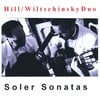Today we released a video of 'Chill 22', the first track from the new album 'Standing on Air'
The album itself, featuring all original compositions by Robin and on which he plays all the instruments, will be available in January 2012, but we thought it would be nice for you all to have a sneak preview.
This composition was inspired by Robin's newly acquired Manuel Reyes guitar which was made by the master luthier in 1963. This instrument is capable of producing not only the aggressive rasp of the Andalusian flamenco, but also a beautiful sweetness of tone when played with sensitively and expression.
As he was in a hotel at the time, the title of the track was taken from his room key and initials, 'Chill 22', his first name being Charles.
As time went on the piece evolved.
Chill 22 has a laid back jazz groove yet the incisive triplets and use of rasgueados reflect Robin's love of flamenco music. The cuica drum, rainstick and shakers are Brazilian inspired.
Alongside these latin and flamenco elements you may also discover a quote from Igor Stravinsky's, 'Rite of Spring'.
This is one of Robin's favourite classical pieces and the tongue in cheek reference opening the guitar solo pays tribute to this.
Generally the album as a whole not only reflects Robin's diverse musical tastes but also his constant extensive travelling.
The influences of many countries can be heard in each and every track and he often returns home with an indigenous instrument from some far flung land.
Chill 22 also features a Neapolitan mandolin.
Back in 2008 Robin was in Sorrento when he came across the most beautiful mandolin.
The story about how we came about purchasing it is quite amusing, and restores ones faith in humanity.
Here's 'The Mystery of the Mandolin'.
The use of the mandolin was also an opportunity for Robin to use his enviable plectrum technique acquired after many years of playing electric guitar....
You will have to wait a little longer to hear all 14 original compositions from, 'Standing on Air', but for now, sit back and enjoy 'Chill 22'.
Reviews
'As always, it was sheer pleasure to observe Robin Hill's remarkable fluent technique: everything looks easy when he plays it.' Colin Cooper- Classical Guitar Magazine -----
'Wonderful for their (Hill & Wiltschinsky) precision, touch and clarity of sound... refined virtuosity, the achievement of a long interpretive process.' Il Giornale D'Italia (Rome) -----
'I loved your CD and thought your technique and performance were fabulous...' Rick Wakeman
Tuesday, November 22, 2011
'Chill 22' - Robin Hill from the new album 'Standing on Air'
Labels:
Brazilian,
Chill 22,
Classical music,
cuica,
flamenco,
guitar,
Igor Stravinsky,
Jazz,
Mandolin,
Manuel Reyes,
rainstick,
rasgueado,
Robin Hill,
Standing on Air,
The Rite of Spring,
travelling
Friday, October 07, 2011
'The Scale' from The Guitar Gymnasium - Robin Hill
Some time ago I wrote a post on 'The Arpeggio' and promised to follow up with one about scales.
So here it is!
Scales are a vital part of any practice session and should be treated with respect.
As Andres Segovia once said,
'The practice of scales enables one to solve a greater number of technical problems in a shorter time than the study of any other exercise.'
Below are the first two pages of Chapter 2 of The Guitar Gymnasium.
The entire chapter consists of 16 pages of explanations and guidance, the occasional inspiring quote, 13 original exercises and a few old favourites.
The original exercises have been designed by Robin to achieve many things.
Some are excellent warm-up and stamina building exercises, others concentrate on avoiding awkward string crossings by examining technique.
You can click on the image to enlarge if required.


Throughout the chapter Robin reiterates that the printed fingering in any book is not sacred. Usually there are a number of alternatives and one shouldn't be afraid to experiment.
He finishes the chapter with the demanding scale workout by Nicolo Paganini, 'Moto Perpetuo', which he has transposed from C major to A major and fingered to facilitate fluency and velocity.
As Robin says at the end of the chapter....'Good Luck'
So here it is!
Scales are a vital part of any practice session and should be treated with respect.
As Andres Segovia once said,
'The practice of scales enables one to solve a greater number of technical problems in a shorter time than the study of any other exercise.'
Below are the first two pages of Chapter 2 of The Guitar Gymnasium.
The entire chapter consists of 16 pages of explanations and guidance, the occasional inspiring quote, 13 original exercises and a few old favourites.
The original exercises have been designed by Robin to achieve many things.
Some are excellent warm-up and stamina building exercises, others concentrate on avoiding awkward string crossings by examining technique.
You can click on the image to enlarge if required.


Throughout the chapter Robin reiterates that the printed fingering in any book is not sacred. Usually there are a number of alternatives and one shouldn't be afraid to experiment.
He finishes the chapter with the demanding scale workout by Nicolo Paganini, 'Moto Perpetuo', which he has transposed from C major to A major and fingered to facilitate fluency and velocity.
As Robin says at the end of the chapter....'Good Luck'
Monday, July 25, 2011
'Life of a Musician' - 5 Years of Blogging
Life of a Musician is 5 years old today!
So, I thought I would have a look back through some of the 717 posts and highlight a few that represent a cross section of the last 5 years.
To start with you might like to listen to some of the pieces in the player in the sidebar. If so, this post, 'Stories Behind the Music' tells you a little about each piece.
Also in the sidebar are some of our CDs which can be accessed by clicking the various links.
But apart from the music the whole point of this blog was to look behind the scenes at the life of a musician and to record some memories and thoughts from a career that has spanned more than 40 years...
'Accidents Happen: Part 1' seemed a good place to start.
And then there was, 'Part 2'.
I'm not saying Robin is accident prone but this post tells about the time he split his guitar - during a concert...and this one how he found himself, 'Recording for Teldec with a Sutured Finger'.
Travel obviously forms a huge part of the life of this musician. Generally this is an honour. He visits more countries each year than most people manage in a lifetime. But it isn't without its stresses.
We have had 'lost guitars', and more lost luggage than I care to remember, here's just one example, 'A Case of the Borrowed Tuxedo'.
But fun can be had, especially when live on radio in the US, 'Hill/Wiltschinsky - Pump It or Dump it'.
And you know you've been too New York frequently when this happens!
Occasionally I would add a more technical post such as, 'See the Sound Waves and Improve your Scales', or, 'Music Practice Tips - Classical Guitar'.
Of course many people want to know about being the 'wife' of a musician, which prompted this series of posts: 'The Wife of a Musician - Part 1 - The Music', and 'Part 2 - Travel', and for those really dedicated to the role of the wife of a musician you can find a few more links here.
But sometimes the blog posts just reflect what is happening at the time...how could I resist this one, 'Cabo San Lucas, Hard Rock Cafe and the Tale of an Iguana', or 'Manuel de Falla's, 'Miller's Dance', and the Solar System', or this one, 'Django Reinhardt, Stephane Grappelli and the Revolving Stage'.
No blog discussing the guitar would be complete without mentioning, 'Guitarists and Their B***** Nails'...
Finally, a few posts that have been particularly popular over the years, 'Sex, Drugs and Classical Music', 'Alicia de Larrocha, the Ritual Fire Dance and a Maths Exam' and 'Inspire Young Minds with Music'.
However, these are just a handful of the available posts, there are several hundred more, all of which can be found through the archives.
Many thanks to all those who have supported 'Life of a Musician' over the last 5 years and I hope you will continue to do so for many more to come.
So, I thought I would have a look back through some of the 717 posts and highlight a few that represent a cross section of the last 5 years.
To start with you might like to listen to some of the pieces in the player in the sidebar. If so, this post, 'Stories Behind the Music' tells you a little about each piece.
Also in the sidebar are some of our CDs which can be accessed by clicking the various links.
But apart from the music the whole point of this blog was to look behind the scenes at the life of a musician and to record some memories and thoughts from a career that has spanned more than 40 years...
'Accidents Happen: Part 1' seemed a good place to start.
And then there was, 'Part 2'.
I'm not saying Robin is accident prone but this post tells about the time he split his guitar - during a concert...and this one how he found himself, 'Recording for Teldec with a Sutured Finger'.
Travel obviously forms a huge part of the life of this musician. Generally this is an honour. He visits more countries each year than most people manage in a lifetime. But it isn't without its stresses.
We have had 'lost guitars', and more lost luggage than I care to remember, here's just one example, 'A Case of the Borrowed Tuxedo'.
But fun can be had, especially when live on radio in the US, 'Hill/Wiltschinsky - Pump It or Dump it'.
And you know you've been too New York frequently when this happens!
Occasionally I would add a more technical post such as, 'See the Sound Waves and Improve your Scales', or, 'Music Practice Tips - Classical Guitar'.
Of course many people want to know about being the 'wife' of a musician, which prompted this series of posts: 'The Wife of a Musician - Part 1 - The Music', and 'Part 2 - Travel', and for those really dedicated to the role of the wife of a musician you can find a few more links here.
But sometimes the blog posts just reflect what is happening at the time...how could I resist this one, 'Cabo San Lucas, Hard Rock Cafe and the Tale of an Iguana', or 'Manuel de Falla's, 'Miller's Dance', and the Solar System', or this one, 'Django Reinhardt, Stephane Grappelli and the Revolving Stage'.
No blog discussing the guitar would be complete without mentioning, 'Guitarists and Their B***** Nails'...
Finally, a few posts that have been particularly popular over the years, 'Sex, Drugs and Classical Music', 'Alicia de Larrocha, the Ritual Fire Dance and a Maths Exam' and 'Inspire Young Minds with Music'.
However, these are just a handful of the available posts, there are several hundred more, all of which can be found through the archives.
Many thanks to all those who have supported 'Life of a Musician' over the last 5 years and I hope you will continue to do so for many more to come.
Monday, May 30, 2011
'The Arpeggio' from 'The Guitar Gymnasium'
Robin is frequently asked how he maintains speed, accuracy and fluency for prolonged periods whilst playing the guitar.
Although this may not be what aspiring performers want to hear, one of the answers lies in, 'The Arpeggio'.
The Arpeggio is a basic technique which is encountered in nearly every piece and is an excellent and essential technical exercise.
Even after more than 40 + years as a performer Robin will still practise arpeggios on a regular basis.
Chapter 1 of Robin Hill's, 'The Guitar Gymnasium' focuses solely on the arpeggio and contains 18 pages of explanations, advice, quotes and original exercises.
Today I have decided to show you the first two pages as an example of the approach Robin uses.
Click on the image to enlarge if required.


As Robin says later in the chapter, 'These exercises should be taken at a slow (60bpm) tempo initially gradually increasing the tempo. Practise with a metronome is recommended (but not all the time). The exercises should be played with fluency and technical command, accuracy is paramount.'
Good luck and keep checking in as next we will look at the tricky area of, 'The Scale'....
Although this may not be what aspiring performers want to hear, one of the answers lies in, 'The Arpeggio'.
The Arpeggio is a basic technique which is encountered in nearly every piece and is an excellent and essential technical exercise.
Even after more than 40 + years as a performer Robin will still practise arpeggios on a regular basis.
Chapter 1 of Robin Hill's, 'The Guitar Gymnasium' focuses solely on the arpeggio and contains 18 pages of explanations, advice, quotes and original exercises.
Today I have decided to show you the first two pages as an example of the approach Robin uses.
Click on the image to enlarge if required.


As Robin says later in the chapter, 'These exercises should be taken at a slow (60bpm) tempo initially gradually increasing the tempo. Practise with a metronome is recommended (but not all the time). The exercises should be played with fluency and technical command, accuracy is paramount.'
Good luck and keep checking in as next we will look at the tricky area of, 'The Scale'....
Wednesday, March 16, 2011
Pearl of Strings
As all guitarists know the type of string used can make a huge difference to a performance.
It is therefore always a delight to come across a product which really makes a difference.
However, not so much of a delight when the newly released strings are currently unavailable and you have a tour pending.
This is the situation we found ourselves in recently.
Robin was in Australia having just completed a trip, and he asked me to order 6 new sets of, Cantiga New Cristal 510 CR strings, urgently.
With only 5 days at home there was little room for delay.
However, after trying all our usual outlets, the new Cantiga strings were proving difficult to obtain. The problem was that they are very new. Just being launched and, as yet, not readily available.
As these new strings really worked better than any others on his instruments he was reluctant to use anything else. In fact the analogy he used was, 'It would be like driving a Polo when you have been used to a Porsche....'
But help was at hand.
Savarez heard of our plight and immediately sent 6 sets for the forthcoming trip.

Robin was delighted, and whilst he was still away I asked him to write down his thoughts on guitar strings and why these were so important. This is what he sent:
Pearl of Strings
I am always experimenting with different guitar strings and all have
different characteristics and qualities (and defects in some cases). They also have the ability to substantially colour and change the voice of an instrument.
My two main classical guitars are made by the great Miguel Rodriguez of Cordoba, a 1980 cedar top and a 1976 'Churchdoor' cedar top. Both instruments are outstanding. I also have a 1963 flamenco by Manuel Reyes.
In my early playing days at college and with the Hill/Wiltschinsky Duo I
used Savarez Pink Card strings......these can be heard on our debut recording, 'Arrival' on iTunes. Over the years I have tried just about every available string by numerous different manufacturers.
Whenever a new string appears on the market I am eager to try it. Thus it
was with the new Cantiga strings by Savarez.
They are a revelation, possessing an unequalled resonance, sustain,
intonation and longevity and a pleasing lack of abrasiveness which is kind to the nails.
In short I consider these strings to be a quantum leap in the evolution of
the classical guitar string.
Nothing else currently available compares.
Robin Hill – 2011
I was equally delighted with the rather nice pen they also sent:

And if you are wondering what happens to all these strings once the concert has been performed, well, you may be interested in this old post, 'The Many and Varied Uses of Savarez Guitar Strings'.
It is therefore always a delight to come across a product which really makes a difference.
However, not so much of a delight when the newly released strings are currently unavailable and you have a tour pending.
This is the situation we found ourselves in recently.
Robin was in Australia having just completed a trip, and he asked me to order 6 new sets of, Cantiga New Cristal 510 CR strings, urgently.
With only 5 days at home there was little room for delay.
However, after trying all our usual outlets, the new Cantiga strings were proving difficult to obtain. The problem was that they are very new. Just being launched and, as yet, not readily available.
As these new strings really worked better than any others on his instruments he was reluctant to use anything else. In fact the analogy he used was, 'It would be like driving a Polo when you have been used to a Porsche....'
But help was at hand.
Savarez heard of our plight and immediately sent 6 sets for the forthcoming trip.

Robin was delighted, and whilst he was still away I asked him to write down his thoughts on guitar strings and why these were so important. This is what he sent:
Pearl of Strings
I am always experimenting with different guitar strings and all have
different characteristics and qualities (and defects in some cases). They also have the ability to substantially colour and change the voice of an instrument.
My two main classical guitars are made by the great Miguel Rodriguez of Cordoba, a 1980 cedar top and a 1976 'Churchdoor' cedar top. Both instruments are outstanding. I also have a 1963 flamenco by Manuel Reyes.
In my early playing days at college and with the Hill/Wiltschinsky Duo I
used Savarez Pink Card strings......these can be heard on our debut recording, 'Arrival' on iTunes. Over the years I have tried just about every available string by numerous different manufacturers.
Whenever a new string appears on the market I am eager to try it. Thus it
was with the new Cantiga strings by Savarez.
They are a revelation, possessing an unequalled resonance, sustain,
intonation and longevity and a pleasing lack of abrasiveness which is kind to the nails.
In short I consider these strings to be a quantum leap in the evolution of
the classical guitar string.
Nothing else currently available compares.
Robin Hill – 2011
I was equally delighted with the rather nice pen they also sent:

And if you are wondering what happens to all these strings once the concert has been performed, well, you may be interested in this old post, 'The Many and Varied Uses of Savarez Guitar Strings'.
Monday, February 07, 2011
'Performance and Practice' from 'The Guitar Gymnasium'
For many years Robin carried around a notebook, and whenever he came across a quote that he found inspiring and/or thought-provoking he wrote it down.
Eventually, he wrote, 'The Guitar Gymnasium - A Mental and Physical Workout, Designed to Develop Flawless Technique,' (Mel Bay) and incorporated many of these quotes.
Whilst the book is aimed at guitarists, there is a whole chapter dedicated to Performance and Practice. This section covers the many psychological factors inherent in the performance of music, but could equally apply to artists of all areas.
The following is an extract from. 'The Guitar Gymnasium'.
Performance and Practice
A Collection of Thoughts
I firmly believe that attaining the balance between self-confidence and self-doubt is one of the artist's most important challenges:
'It constantly remains a source of disappointment to me that my drawings are not yet what I want them to be, the difficulties are indeed numerous and great, and cannot be overcome at once. To make progress is a kind of miner's work; it doesn't advance as quickly as one would like, and others also expect, but as one stands before such a task, the basic necessities are patience and faithfulness. In fact, I do not think much about the difficulties, because if one thought about them too much one would get stunned or disturbed.'
Vincent Van Gogh (letter to Theo)
If Vincent had not felt like this about his work it would have, indeed, been a surprise. This sense of striving and self-dissatisfaction provide the essential impetus to spur the artist to further and higher achievements. Eventually, as we all know, he did get the balance wrong, he did become stunned and disturbed, and the world lost one of it's greatest artists. We all have encountered his antithesis where small talent is buoyed up by outrageous conceit.
'The superior man is distressed by his want of ability' Confucius 551-479 BC
Confucius points out the paradox which propels high-achievers forward toward greater heights.
'
The eternal problem for the performer is the settling of his own mental equilibrium, the striking of a happy mean between conceit, self-confidence and a sober valuation of his worth.'
'Let us remember when we witness an artist on the platform radiating the most sublime self-assurance that in reality, he may be extremely modest and nervous, that he has donned a cloak of self-complacency to disguise his fright. For my part I am aware, when acknowledging applause, that I wear my warmest smile when I know that I have played badly; the smile helps me to walk off the stage and masks my fury. A bad performance haunts an artist for days and days and the memory of it is only erased by a good one. The most vigilant self-criticism is of course necessary. but the time comes when the artist must tell himself he is good or he will go under. It is a fight.'
Gerald Moore (Am I too Loud?)
This quote, by the accompanist, Gerald Moore, perfectly encapsulates the dilemma.
'Something like a nervous dread often takes possession of me while I am on stage in the presence of a large audience....one can only imagine how painful this sensation maybe....this sense of uncertainty has often inflicted upon me tortures only to be compared with the Inquisition, while the public listening to me imagines that I am perfectly calm.'
Anton Rubinstein
'The guitar is very curious, I always say the guitar behaves unpredictably because of the influence of its feminine curves. (Sorry - I know this is politically incorrect - but it's what the man said!) When I go to the concert I am always nervous; then when I begin the concert I am ready to cancel it; but when I have finished the concert, I would like to begin again.'
Andres Segovia
And you thought you had problems!
I find these quotations both inspiring and comforting. It is surprising to many people to learn that great artists and performers were and are assailed by these feelings of dread and self-doubt. One of the factors which define their greatness is how they react to these doubts. If they are completely banished complacency flourishes and a powerful motivator is lost, but if this doubt gains the upper hand then confidence and further progress will be severely impeded. The trick is to get the balance right. This state of equilibrium is difficult to attain and difficult to maintain, requiring almost constant adjustment. The secret of success is how we react to failure. There is no doubt that a realistic belief in oneself provides a potent impetus to successful performance and vice versa.
In my experience of concert giving over some twenty-five years, I have found that no matter how pleased (rarely) or disappointed (frequently) I am concerning the performance it is, objectively, never as good or as bad as perceived. As a member of an audience, I also note that what communicates, above all, is the spirit of the performance and not the fine detail. Obviously one has to aim for technical perfection, but for a performer to be convinced a whole concert was appalling because there were a few slips is clearly wrong.
In fact, I remember a very memorable recital at the Wigmore Hall at which I was present and which I very much enjoyed, it was also repertoire with which I was largely familiar. I was convinced the performance was note-perfect as well as truly inspiring and musical. When, months later, I heard the concert broadcast 0n BBC Radio 3, I was amazed to hear a few obvious errors but found I had been correct about the event being truly musical and inspiring. This experience taught me a valuable lesson - If the inspiration and spirit of the music, and say 85-95% accuracy, are present, then that concert is a great success and an uplifting event for the audience (of whom maybe 1-3% will have noticed the errors) and, if the other necessary factors were present, this will not have marred their enjoyment of the concert as a whole.
Subscribe to:
Posts (Atom)

















